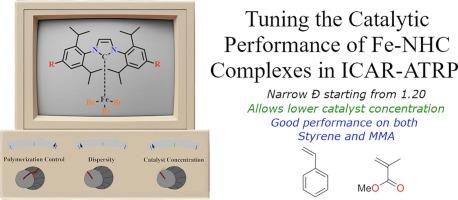Synthesis of N-Heterocyclic carbene complexes with different substituents to tune the electron density of iron center and their catalytic performance in ICAR-ATRP
IF 6.3
2区 化学
Q1 POLYMER SCIENCE
引用次数: 0
Abstract
Iron-based N-heterocyclic carbenes (NHCs) have been demonstrated to be a promising catalysts in atom transfer radical polymerizations (ATRP). However, the critical role of electron density surrounding the core metal ion and its influence on the catalyst’s activity is still vague. The objective of this study is to elucidate the relationship between the electron density of the metal center and catalytic activity using initiators for continuous activator regeneration (ICAR) ATRP. To this end, a set of four distinct NHCs were synthesized, characterized, and their activities were examined in the context of ICAR-ATRP employing various monomers, namely methyl methacrylate and styrene. The electron density surrounding the metal center in Fe-based complexes (FeX3(NHC)) was regulated through the utilization of diverse substituent groups, including −OCH3, −I, −CN, and −H. The electronic properties of the catalysts were investigated by density functional theory (DFT) calculations. The polymerization results demonstrated improved control over the process with increasing electron-donating characteristics of the substituent groups on the NHC ligand. The catalyst exhibited enhanced control over the polymerization process, as evidenced by narrow dispersity values ranging from 1.33 to higher for methyl methacrylate and from 1.14 to higher for styrene. Additionally, high conversion ratios of up to 50 % were observed for both monomers, even at relatively low catalyst concentrations ranging from 50 to 250 ppm.

不同取代基的n -杂环羰基配合物对铁中心电子密度的调节及其在ICAR-ATRP中的催化性能
铁基n-杂环碳烯(NHCs)是一种很有前途的原子转移自由基聚合(ATRP)催化剂。然而,围绕核心金属离子的电子密度的关键作用及其对催化剂活性的影响尚不清楚。本研究的目的是阐明在连续激活剂再生(ICAR) ATRP中使用引发剂的金属中心电子密度与催化活性之间的关系。为此,合成了四种不同的NHCs,对其进行了表征,并在采用不同单体(甲基丙烯酸甲酯和苯乙烯)的ICAR-ATRP环境下对其活性进行了研究。铁基配合物(FeX3(NHC))金属中心周围的电子密度通过利用不同的取代基,包括−OCH3,−I,−CN和−H来调节。用密度泛函理论(DFT)计算了催化剂的电子性质。聚合结果表明,随着NHC配体上取代基给电子特性的增加,对聚合过程的控制得到了改善。催化剂对聚合过程的控制能力增强,甲基丙烯酸甲酯和苯乙烯的分散度值分别在1.33和1.14之间。此外,即使在相对较低的催化剂浓度(50至250 ppm)下,也观察到两种单体的高转化率高达50%。
本文章由计算机程序翻译,如有差异,请以英文原文为准。
求助全文
约1分钟内获得全文
求助全文
来源期刊

European Polymer Journal
化学-高分子科学
CiteScore
9.90
自引率
10.00%
发文量
691
审稿时长
23 days
期刊介绍:
European Polymer Journal is dedicated to publishing work on fundamental and applied polymer chemistry and macromolecular materials. The journal covers all aspects of polymer synthesis, including polymerization mechanisms and chemical functional transformations, with a focus on novel polymers and the relationships between molecular structure and polymer properties. In addition, we welcome submissions on bio-based or renewable polymers, stimuli-responsive systems and polymer bio-hybrids. European Polymer Journal also publishes research on the biomedical application of polymers, including drug delivery and regenerative medicine. The main scope is covered but not limited to the following core research areas:
Polymer synthesis and functionalization
• Novel synthetic routes for polymerization, functional modification, controlled/living polymerization and precision polymers.
Stimuli-responsive polymers
• Including shape memory and self-healing polymers.
Supramolecular polymers and self-assembly
• Molecular recognition and higher order polymer structures.
Renewable and sustainable polymers
• Bio-based, biodegradable and anti-microbial polymers and polymeric bio-nanocomposites.
Polymers at interfaces and surfaces
• Chemistry and engineering of surfaces with biological relevance, including patterning, antifouling polymers and polymers for membrane applications.
Biomedical applications and nanomedicine
• Polymers for regenerative medicine, drug delivery molecular release and gene therapy
The scope of European Polymer Journal no longer includes Polymer Physics.
 求助内容:
求助内容: 应助结果提醒方式:
应助结果提醒方式:


